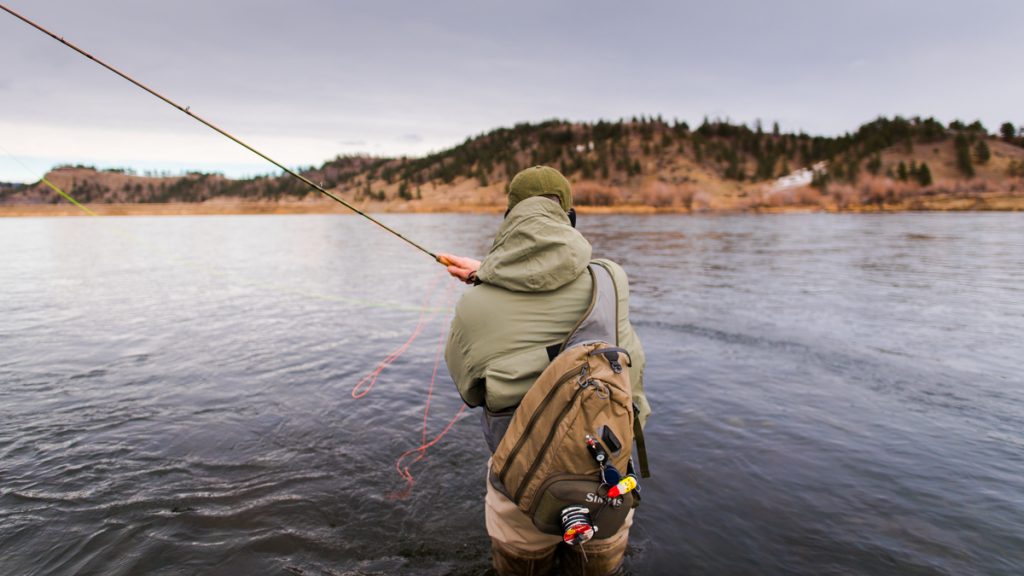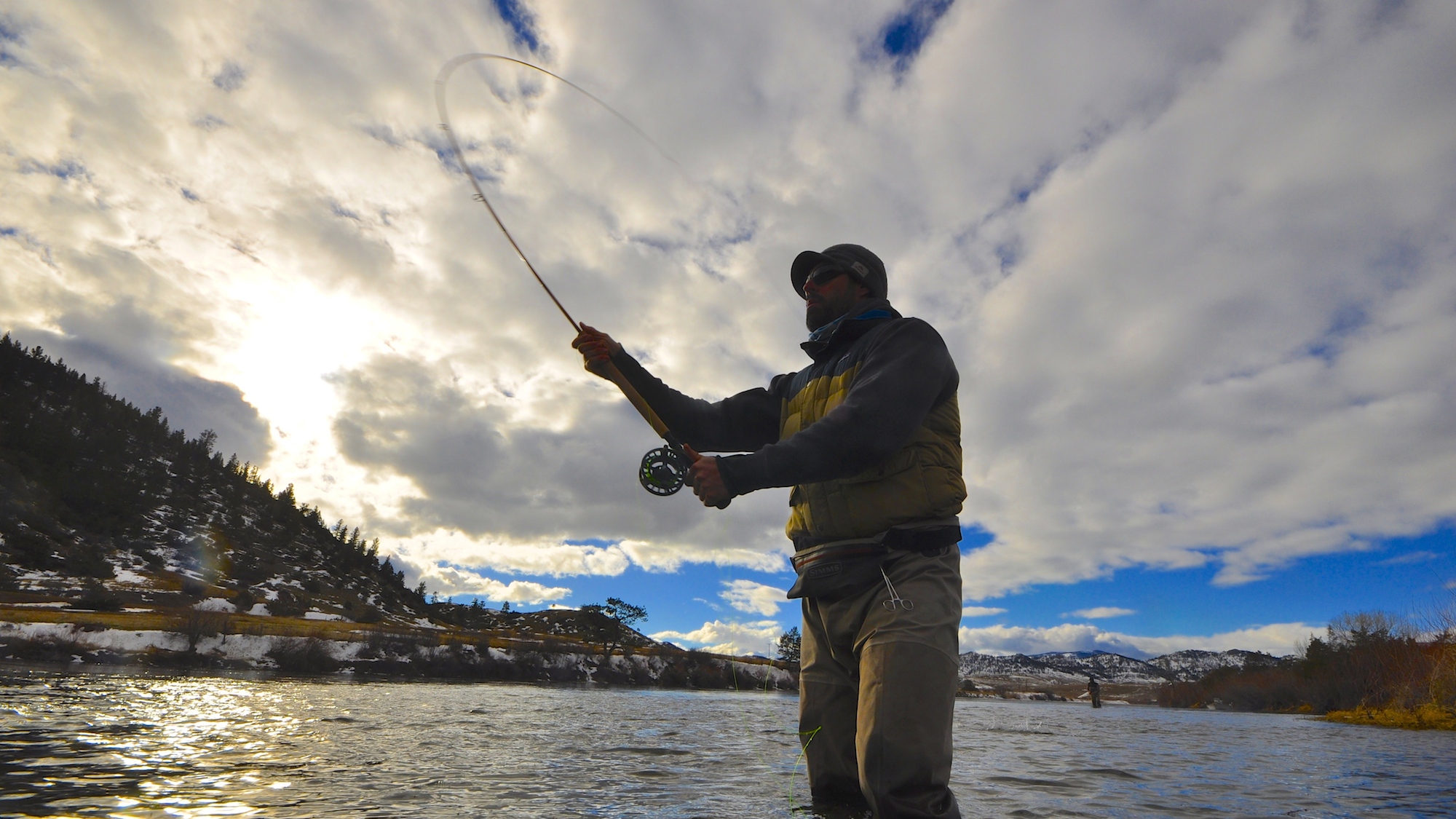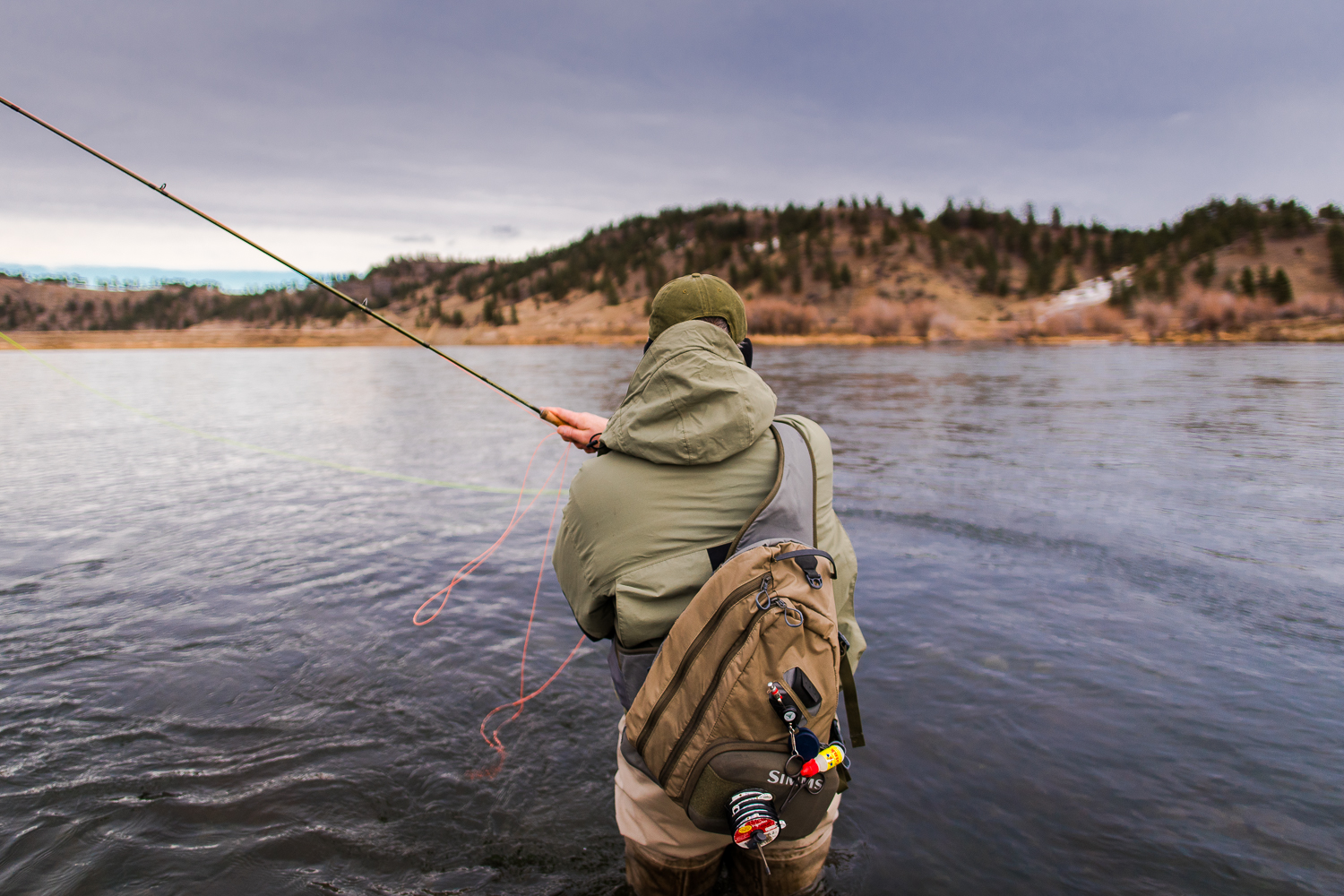Lately I’ve seen a resurgence in the dreaded “switch” line. Particularly on newer spey rigs purchased regionally. At our last clinic there were no less than 3 new outfits present rigged with switch lines. All were recommended as part of a rod/reel/line kit from where they were purchased. All 3 left the clinic optimized for spey casting with standard Skagit or Scandi shooting heads, and happier owners.
I’ve been bashing switch lines for years, and thought I had gotten in front of the disease. Apparently it has emerged as a new strain that is more resistant to my opinion. Or maybe just more folks are buying their spey gear in the Northern Rockies, where it’s less likely you’ll run into a knowledgeable spey technician, than in, say, Portland or Seattle.
While I’ll admit that in the last 2 years I have finally seen some useable switch lines, they still represent such a huge compromise that there is no way I can recommend them, nor have I ever met an experienced caster who prefers them over Spey lines. Or even uses them.
So let’s back up quickly, and review what these lines are designed for…
The term “switch” was first applied to rods short and light enough to be used as a single hander, and long enough to be used for spey casting. Remember that at the time a 13′ #7 spey rod was considered small, so the jump down to 11 feet was drastic. The problem was that no lines existed that would perform spey casts on these new rods. And if they did, you certainly could have used those lines on your single handed 9′ 5 weight to spey cast. So really, these were just shorter spey rods, and it baffles me why they didn’t refer to them as that. By building “switch rods”, however, manufacturers unwittingly sped up the trend towards shorter and lighter two-handed rods. In fact we’ve now reached the point where the difference in length between a “switch” rod and a “spey” rod is measured in inches, not feet.
Instead of designing much needed short-head spey lines for this new category of rods, manufacturers decided to match the new lines to the term, instead of the rod and the customers demand. Also, some of the rods were “overhead” 6 weights, and some were “spey” 6 weights. So we ended up with a bunch of switch rods and switch lines that had no consistency in length, taper, or grains across the industry. Nobody had a clue how to design a line that could perform powerful spey casts and act as a traditional overhead fly line. Because it can’t really be done. More on that later.
Now 5 years ago, there were still some folks around talking “switch”. The idea that you could spey cast down through a run, then turn around and upstream fish back up in single handed fashion (with the same fly line). But those that tried quickly found out that; a) most switch lines were terrible spey lines; b) spey lines are way too heavy to single hand cast effectively, and c) throwing dry flies on a switch rod sucks.
But for each angler I talked to looking for a true switch set-up, I talked to 100 who were looking for a small spey rod. I really don’t hear the “switch” discussion anymore, although there are no doubt rivers – or more likely runs – that do benefit from the ability to do this quickly with one outfit. But like I said, you could do it with your 9′ 5 weight with the right line (Wulff Ambush). And while I do run into folks who ended up with a switch line as part of their new Spey kit, few of them asked for it. Simply a case of an uninformed salesman innocently matching up the rod, reel and line out of the catalog. In other words, if you ask for a switch rod – and don’t ask for a particular line – you may well end up with a switch line.
You’re hearing what sounds like a little fly shop criticism here. In reality, I’m pointing out the fact that we live in Montana, and nobody should expect every fly shop employee in the region (and no Big-Box) to be an authority on Spey lines. Just like you shouldn’t expect a Montana fly shop employee to be an expert at rigging billfish leaders. Or a Florida fly shop employee to know what Gink is. Many of them need a little direction from you.
Back to the Clinic…
So, back to our last clinic and 3 poorly lined rigs. The first two were matching off-brand rod,reel,line outfits. They were good rods, termed “switch”, and were lined up with very long belly “switch” lines with heads past 50 feet long. The owners said they performed flawlessly while overhead casting nymph rigs, but they couldn’t seem to spey cast them at all. No doubt. Neither could I. Felt like sewing thread. For these two I went to the other end of the spectrum and quickly rigged them both up with short Skagit heads from OPST and Airflo. Both rod owners loved them, and quickly picked up a couple of spey casts now that they could feel the line doing it’s thing. They also quickly realized that they needed two reels and lines for their rods, as they wanted to continue to use the switch line for single handed casting. An Echo Ion reel for $79 solved that problem.
They also went out and swung several nice Missouri River trout after our clinic on the Skagit head/sink-tip/streamer combo.
The second rod was the Orvis Clearwater switch with the Orvis Hydros Switch Line. I have cast this line quite a bit, and consider it one of the best of the switch lines (second to the Wulff Ambush). It is a true 50/50 compromise – unlike the above example – and performs spey casts much better with it’s shorter, heavier head. But it’s still a massive compromise. Look at it this way, it casts both spey and overhead, but it also performs both styles of casting half as well. This angler could feel what was going on better than the other two, but could not get the power to transfer from his hands to the line. This is because ALL switch lines are underlined compared to their Spey cousins (or all Spey lines are overlined). They have to be so that overhead casts can be performed.
Gary Sandstrom, designer of the Wulff Ambush lines understands this:
Typically a good starting point for switch rods is an Ambush 8 weight (290 grains) will load a 5 weight switch rod, Ambush 9 for a 6wt switch and a Ambush 10 for a 7wt switch (rated for spey application). If the rod is a true single hand, then just match the same Ambush line weight to the rod line weight.
So, Sandstrom and Wulff say +3 line sizes for Spey, and stay at recommended for traditional overhead casting and rods. Thats a massive difference in grains, and is the reason that designing a switch line that performs well in both disciplines is nearly impossible.
This angler was interested in accurate and powerful spey casting, and understood the technique. Looking around I think he quickly realized that the switch line was not going to provide the performance of a true shooting head. He asked me if he should try a Scandi head before I could even bring it up. After rigging it up, he didn’t really have to change much. His technique was already solid. If anything he powered down, as he now had a properly balanced outfit and a line he didn’t have to fight. Booming casts out there with control and ease.
Lesson: If you want to spey cast, get a Spey line.
But remember, the problem was that the right lines didn’t exist for these shorter rods. We often ended up with shooting heads a touch too long and lacking the ability to add – and turnover – a sink tip and large streamer. Finally, we are now seeing the extremely short head spey lines to match these shorter rods perfectly. These new lines are also built in ultralight weights for the new generation of “Micro” or “Ultra-light” spey rods that range from 2 to 4 weight. No line has been more popular at our shop this year than the OPST Commando Skagit heads. These have been designed from the ground up for shorter spey rods, and lengths range from 12′-18′ and 150-475grains. I would call customer satisfaction 100%, and I would include our shop staff in that. Airflow makes the Skagit Compact Switch (hate that name), which is a great line but substantially longer at 19′-20′. RIO makes the Skagit Trout Max, which is best for very short rods with it’s 11′ head length, and is only available in the lightest grain weights. These are all Skagit heads that require the addition of a tip (floating or sinking), and have the ability to fish deep and throw large-ish flies.
Now we just wait for the 18′ Scandi head I hope to see from someone this summer.
So, forget the term “switch”. Throw it away. If you’re on this site reading this post, you’re likely looking for a smaller spey rod used for Spey casting for trout and other resident fish. If so, you probably live around fisheries that you fish with a single hander and a bobber all the time. Why would you look for a spey rod to do that with?
And if you do want to roll a “switch” rig, I recommend you stick with a single handed rod, and perform single-handed spey casts with a short head line like the Wulff Ambush (18′). If you want to swing streamers on foot, and strip them from the boat, the OPST Commando is an excellent choice, and we are selling those heads for that purpose as well. None of the switch or spey lines are useable for technical dry fly fishing.
Most importantly, find a local fly shop rat who knows the spey game. And they don’t need decades of experience in the Skeena drainage to be of assistance. It means he or she has educated themselves when it comes to spey gear – in particular lines – and are enthusiastic about and practice two-handed fishing.





18 Comments.
[…] John Arnold at Headhunters has knocked one out of the park with a recent post – In Defense of Switch Lines….Just Kidding. […]
Two handed from the beach for stripers in New England is similar to casting to trout with a sink tip, but here the true meaning of “switch” refers to going from spey style casts to two handed overhead casts. I’ve heard the OPST lines work well in this condition, but with my single handed rig an intermediate line or full sinking line is typically used. What would you recommend in this scenario for a line where the casting goal is to maximize the distance.
I have no experience with Stripers from the Beach, but from what I understand the “switch” rods used are really powerful two-handed overhead rods, with a fast action more in line with single handers. I have cast several, and they are typically much shorter for their line weight compared to traditional Spey rods. I have used a few of these “beach” rods in BC for pacific Salmon. I believe Beulah makes a series for this purpose, and we have had a few show up at our spey clinic.
As for distance casting, in theory a shooting head system with mono shooting line will always win. Mono can be difficult to handle in situations where you have to strip line in, so I’m not sure what Striper anglers use for shooting line. As for the OPST head, it’s a floater, but you could certainly get to intermediate depths with a 10 t-11 tip on the end. I am not familiar with what kind of shooting head systems are used in your neck of the woods, but I suspect those that use heads use traditional sinking shooting heads, usually 30′ in length and a uniform sink rate.
How’s that for the longest non-answer you’ve ever seen?
I have been using “short speys” or switch rods for trout for more than five years and you are right on with this report. I have used Ambush line with Airflo Polyleaders up weighted as Sandstrom has recommended. The Rio Switch line does not work for Spey casts. The Rio Switch Chucker is great for Spey casting with polyleaders. The Airflo Switch Float is the best line for Scandi casting and swinging smaller flies an soft hackles with tapered nylon leaders. Integrated lines are best for fishing closer in and smaller rivers.
Nice post! What shooting lines do you recommend for lines like the OPST Commando? Particularly for single handed spey casting.
Chuck- While we usually prefer “coated” shooting lines like the Airflow Ridge, we have found that mono shooting lines definitely outperform coated lines in the lighter sizes. If we are using a mono shooting line, we prefer the OPST Laser Line by a large margin. However, the big drawback to mono is handling the line while retrieving a fly. Especially if your hands are cold and wet. If you are “stripping” a streamer all day, we recommend using a coated line and sacrificing some shoot-ability. If you are fishing on a dead swing all day, then go for the mono and watch it fly. If you are in a heavier grain weight – say 390 and up – then you will have the mass to pull either through the guides. I usually go all “coated” above that mark.
Im a new comer to the Headhunters Arena, not to spey casting however, ive been in pursuit of steelies on a two hander for as long as i can remember but one thing i would like to touch on is the misconception that a switch rod is actually just a really short spey rod, and that the only difference between a true spey is a “mere inches”. this is a fly rod design fallacy. A switch rod taper is truthfully no different then your single hander. a true spey taper is considerably different starting with a stiff tip for line control and quick load transfer, slow middle for casting rod feel and stong butt section for the core of the two hander power. A single hander being a progressive taper, go out and see for yourself, can achieve a spey cast but in my opinion achieves without feel and significant power, there you have it. The switch rod was sold to hundreds of thousands of people that its just a “small spey rod”, essentially just a long single hand rod by design. Just because you can spey cast with your 590 doesnt make it a spey rod. im not bashing anything here at all so dont take this the wrong way, i also single hand spey, it surves its purpose on smaller waters and re purposed my 5wt to throw good sized streamers to rod size appropriate fish. cheers
Ross, I agree 100%, and you may have misinterpreted my disorganized and sloppy writing. In my opinion the “idea” of a switch rod is a bad one, for exactly the reason you said. The design of the rod is entirely different for each purpose, thus it is very difficult to design a line that throws both disciplines properly on one rod. You may hear us say these are simply “small” spey rods, meaning that we see no point in using true switch rods designed on a single handed taper. We don’t use them for both. We promote “switch” rods built with a “spey” taper, as that is all that we use them for. Like you, if we need to “switch”, we use our single handed rods. Thank for commenting. It is nice to know that there are folks around that understand the difference between the two tapers. I cover this in our monthly spey clinics as well.
[…] the history and development of switch lines, John Arnold writes an informational piece about why they might not be the right choice for most anglers. “While I’ll admit that in the […]
John, While I agree that a switch rod is a bastard, It can be pretty handy to have one rod that covers a few bases. Changing rods costs me time and maybe even my sweet slot on a crowded steelhead river, where changing spools alone will keep me going. Also, I think a switch rod with a long belly is an awesome way to indicator nymph when there is limited backcast room and I need a lot of lead and a big float: Instead of sloppy, slow, water-loading false casts, I do a quick two-handed snake roll and cover more water, and can mend further out than any of the one handers around me.
I did buy a Rio Switch Chucker line which (as you predict above) I am not real happy with. What do you think about cutting off the head for use with mono or coated running line?
Dave I’m not sure you’ll like it any better, and I’ve tried that myself unsuccessfully. The long belly is the trick. Shorter heads like the Ambush work great. I’ve been playing around with the Scientific Anglers Adapt switch line this fall (for use as a Scandi line on lightweight spey rods) and really like it. It seems to have the right taper (decent power and turnover) on the front and the right diameter running line which I find is a problem on many of the “switch” lines”. For a long belly switch I can’t think of anything better right now, though I’ve mainly used it on 3 and 4 weight rods. You may want to size up a bit for better spey casting performance and better turnover with heavy nymph rigs. I suspect heavy nymph-rig turnover is an issue for you, and it’s going to be with any of the long belly switch – or spey – lines. What you describe doing – single hand spey, spey, overhead – is exactly what the Ambush was designed for and it will turnover heavy, long nymph rigs. The downside will be clumsy overhead performance, and of course the short head will require more shooting on longer casts. Hope that helps and doesn’t confuse – JA
John, Thanks! I have to say that I did cut the front 18′ off my Switch Chucker and tied it to mono running line and put a MOW T-11 on the end for true spey casting and WOW! So much better than the intact Chucker with the T-11. That chucker tried to straddle the line, but was poor for both uses: head too long and running line and “handling” line to thick and too much friction for spey, but also and “handling taper” and shooting line too flimsy for mending with an indicator. It was a bit tough making the new nail knot go through the guides, since I cut into the thick part of the chucker head, but a tight trim and some Aquaseal did the trick. Next time, I’ll just buy ambush or maybe OPST.
[…] I read this recently and thought it useful. In Defense of Switch Lines…. Just Kidding. – Headhunters Fly Shop […]
About the orvis hydros switch line, I will need a line for shorter, heavy boat nymphing scenarios(+-25′ cast) and stationary wading as well, where more dI stance would be beneficial. I have 11′ 8wt echo. Is this a line I should overline if i decide to purchase it. Only really asking about this line because I have an orvis gift card. Also any other line you might recommend for those situations.
Joe – thats a good switch line and should work for your desired uses. As far as weight it is hard to say without trying it yourself. If you are primarily going to stick with overhead casting, get the #8. If you are going to be doing any spey casting, you will want the #9.
What would be your #1 line recommendation for a Winston 11.5′ 5 WT Microspey being used in a variety of trout rivers and techniques?
A variety of trout rivers and techniques immediately leads to a Skagit line, giving you the versatility to fish a floating or sinking tip and big or small flies. I have fished all of the Winston Micro’s except that one, which I will assume is a bit like the 4 weight. I would recommend either the OPST Commando (around 300-325 grains) or Airflo Scout (360-390) heads. You can significantly change how the rod behaves and what kind of casting stroke is required by moving up or down in grain weights. If you like it slow and effortless, go with the heavier Scout. If you like a quicker stroke, go with the Commando. If you are new to spey casting, the Scout will be easier. If at all possible, try and demo a few heads first. If you want to demo some lines and don’t have a dealer nearby, you can call the shop and we can shoot you some demo’s to try.
Having read through this very interesting thread and having river tested my new outfit, I am now concluding that I may have purchased the wrong line/wrong weight of line for my Sage Pulse Switch rod 8 weight. The line recommended by the tackle dealer is a Rio In Touch Switch Chucker rated 8# rated at 520gms. I mostly use the rod single handed but also overhead on occasions. The single hand casts perform well but the overhead cast are not as effective. The line feels very heavy in relation to the power of the rod. Maybe its my casting technique. I fish small spate rivers in Scotland with plenty of background foliage. Should I go for a lighter weight (#7) Rio Swich Chucker? Any suggestions would greatly welcomed.